North Dakota Small-grain Insects Cereal Leaf Beetle Oulema melanopus (L.) (Coleoptera: Chrysomelidae) (E1230, Revised April 2016)
The cereal leaf beetle (CLB) is an imported insect pest from Europe. It first was detected in Michigan in 1962. Cereal leaf beetle spread into all states east of the Great Plains and into Idaho, Montana, Utah, Wyoming and Washington.
Cereal leaf beetle first was detected in Williams and McKenzie counties of North Dakota in June 2000. Since then, CLB was identified in Burke, Renville and Ward counties in 2013 in the northcentral part of the state, and in Cavalier County in 2015 in the northeastern area.
Cereal leaf beetle can be a serious pest of wheat and barley. However, CLB has not been a major economic insect pest of cereal grains in North Dakota.
Description
Adult — The adult beetle is ¼ inch long with a brightly colored orange-red thorax, yellow legs and metallic blue head and wing covers (Figure 1).
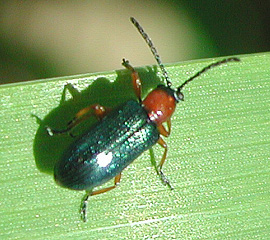
Figure 1. Adult CLB. (Photo by J. Knodel, NDSU)
Eggs — Newly laid eggs are bright yellow, darkening to orange brown and finally to black before they hatch (Figure 2).
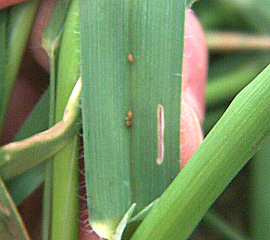
Figure 2. CLB eggs on wheat leaf. (Photo by J. Knodel, NDSU)
Larva — The larva has a light yellow body with brown head and legs (Figure 3). They have three pairs of legs close to the head end. The body is protected by a layer of black, slimy fecal material, which makes them look like a slug (Figure 4). When working or walking in an infested field, the slimy covering will rub off on your clothing.
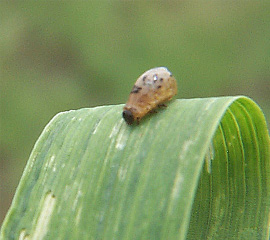
Figure 3. CLB larva without coating and larvae feeding injury. (Photo by V. Chapara, NDSU)
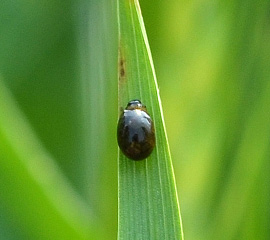
Figure 4. CLB larva with slimy, black coating. (Photo by V. Chapara, NDSU)
Life Cycle
Cereal leaf beetle has one generation per year. Beetles overwinter in shelterbelts and wooded areas in the leaf litter and debris. In the spring, CLB becomes active when temperatures warm to 50 F and feeds on winter or spring grains for about 10 days during May through June. Then female beetles lay eggs, singly or in groups of two or three, on the upper leaf surface near the base of the leaf.
Egg hatch may take from four to 23 days, depending on temperature. Larvae develop in 10 to 14 days during June into July. When mature, larvae dig into the ground to pupate (resting stage). An adult will emerge from the puparium in 10 to 14 days.
The summer beetles feed for about two weeks on grasses, later-seeded cereal grains and corn before estivating (dormant stage) for the remainder of the summer. In the fall, CLB moves to shelterbelts or wooded areas for overwintering.
Damage
The first sign of CLB activity in the spring is adult feeding damage on the plant foliage. Adult prefer newer plant tissue. CLB injury is characterized by elongated, slender slits in the upper leaf surface (Figure 5).
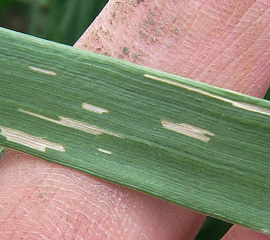
Figure 5. Adult feeding injury. (Photo by J. Knodel, NDSU)
Adults and larvae damage grain crops by feeding on the leaves. The larvae are the most damaging stage. They feed on the leaf surface between veins, removing all the green material down to the lower cuticle, resulting in an elongated windowpane in the leaf (Figure 6). Later, the windowpane will break and peel back as the remaining cuticle desiccates.
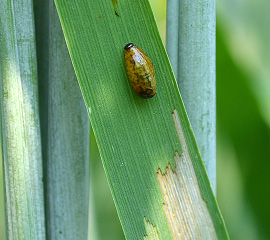
Figure 6. CLB larval feeding. (Photo by V. Chapara, NDSU)
Fields that are severely damaged can have a “frosted” appearance due to the lack of green leaf tissue. Damage by CLB is typically worst when springs are cool and wet. Drought conditions are unfavorable for CLB populations.
This insect pest has been deregulated as of 2014 and is no longer a concern for producers who ship hay/straw to California or Canada.
Host Plants
Cereal leaf beetle has a wide host range, including the cultivated grass hosts of barley, oats, wheat and rye. Adults may feed on corn, sorghum and sudangrass. Beetles may feed on grass weeds, including wild oats, quackgrass, timothy, canary grass, reed canary grass, annual and perennial ryegrass, foxtail, orchard grass, wild rye, smooth brome and fescues.
Scouting
In the spring, inspect plant foliage for adult feeding injury, the first sign of CLB activity. While this is the first sign of infestation, CLB larvae are the target of insecticide control. Insecticide applications targeted at the adult have not been effective in reducing population. Eggs and larvae are monitored by inspecting individual plants.
Thresholds are expressed as egg and/or larval numbers per plant or per stem. Eggs and larvae often are distributed unevenly in a field, so examine 10 plants per location; select at least five locations in a field, and more for larger fields.
Count the number of eggs and larvae per plant (small plants) or per stem (larger plants) and determine an average number of eggs and larvae based on the samples you have taken.
Plant growth stage should be noted because the treatment threshold changes with plant growth stage. Eggs and larvae can be found by examining the upper leaf surface.
A degree day model has been developed for calculating the development of CLB using a base temperature of 44.6 F and starting date of Jan. 1 in Montana. For monitoring CLB, accumulated degree days of 176 are used for monitoring early adult activity, and accumulated degree days of 253 are used for monitoring first egg laying and early larval hatch.
Economic Threshold
Cereal leaf beetle feeding damage can reduce yield and grain quality. The boot stage is a critical point in plant development, and larval feeding can have a general impact on plant vigor.
Before the boot stage, the threshold is three or more eggs and/or larvae per plant, including all the tillers present before flag leaf emergence. Insecticide spray applications should be delayed until 25 percent of the eggs have hatched and larvae have emerged because insecticide treatments are targeted at killing the larvae.
When the flag leaf emerges, feeding generally is restricted to the flag leaf. Damage to this leaf can reduce grain yield and quality significantly. At the boot stage, the threshold is one or more larva(e) per flag leaf.
Pest Management
Natural Control
Lady beetles prey on CLB larvae. Several imported parasitic insects attack CLB, but these parasites have not been determined to be present in North Dakota.
The parasites imported from overseas and established in some areas of the U.S. include Anaphes flavipes, a wasp that parasitizes CLB eggs; Tatrastichus julis, Diaparrsis carinifer and Lemophagus curtus, wasps that parasitize larvae; and Hyalomyodes triangulifer, a tachinid fly that parasitizes adults. CLB has been reduced to a minor insect pest of small-grain crops in areas where the parasites have been established successfully.
Host Plant Resistance
Leaf pubescence has been identified as a source of resistance to CLB in wheat, which resulted in a lower number of eggs laid and reduced leaf-feeding injury by larvae. However, one problem with leaf pubescence is that it is variable, depending on the environment. No CLB-resistant wheat cultivars are available for North Dakota.
Insecticides
Consult the NDSU Extension Service publication “North Dakota Field Crop Insect Management Guide” (E1143) for an updated list of insecticides registered for control of cereal leaf beetle in barley, oats and wheat.
When using a pesticide, always read, understand and follow the label directions. The pesticide label is a legal document.
This publication was authored by Phil Glogoza, former Extension entomologist, NDSU, 2002.
APRIL 2016

